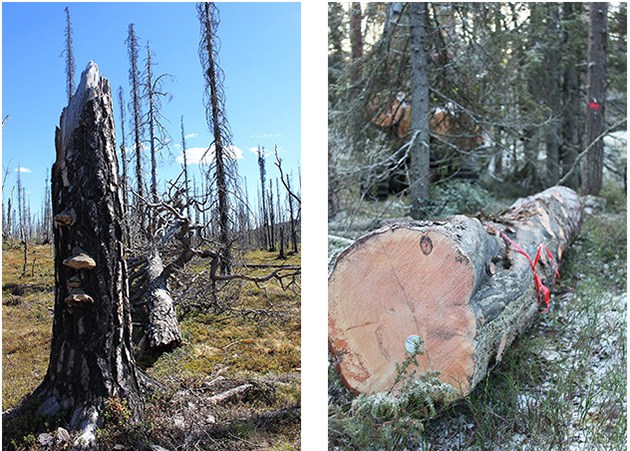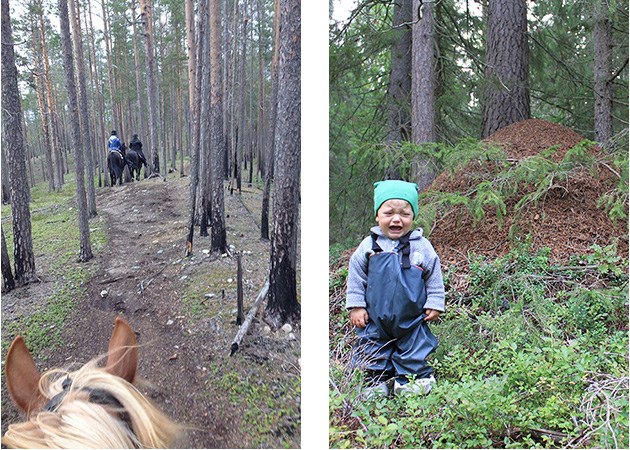Therese Löfroth

Presentation
Mina forskningsintressen
- Död ved
- Biologisk mångfald
- Bevarandebiologi
- Samhällsekologi
- Landskapsekologi
- Entomology
- Restaurering i skogliga ekosystem
- Effekter av nya skogsbruksmetoder
Undervisning
Biträdande prefekt med ansvar för grundutbildning på VFM.
Kursledare för examensarbeten vid VFM.
Undervisar på flera kurser på grundutbildningen samt handleder kandidat- och mastersarbeten.
Forskning
Aktuella projekt:
Långtidseffekter av storskalig skogsbrand på bete och biodiversitet
Korttidseffekter av intensivskogsgödsling på skogens biologiska mångfald
Indirekta effekter av intensiv skogsgödsling
Restaurering av frivilliga avsättningar
Kompensationsåtgärder vid exploatering av skog med höga naturvärden
Bakgrund
Biolog med rötterna i norra Västerbottens kustland. Har läst min grundutbildning vid Umeå Universitet och disputerade 2006 på SLU i Umeå med avhandlingen "The conservation of saproxylic beetles in boreal forest: Importance of forest management and dead wood characteristics".
Handledning
Huvudhandledare för doktorander:
Emelie Fredriksson – Admitted 2017-10-01
Biträdande handledare:
Bell, David - Admitted 2010-08-01, Licenciate degree 2015
Hägglund, Ruaridh – Admitted 2012-07-15, Finished 2016-10-14
Joelsson, Klara – Admitted 2013-08-01, Finished 2017-10-27
Versuljis, Martijn – Admitted 2014-10-01
Publikationer i urval
32. Heloise G., Verdon, S.J., Tom Weir, T., Johansson, T., L’Hotellier, F., Hayward, M.W. Testing top-down and bottom-up effects on arid zone beetle assemblages following mammal reintroduction. Austral Ecology. In press.
31. Hjälten, J., Joelsson, K., Gibb, H., Work, T., Löfroth, T., Roberge, J.-M. 2017. Biodiversity benefits for saproxylic beetles with uneven-aged silviculture. Forest Ecology and Management 402:37-50.
30. Versluijs, M., Eggers, S., Löfroth, T. Hjältén, J., Roberge, J-M. 2017. Ecological restoration in boreal forest modifies the structure of bird assemblages. Forest Ecology and Management 401:75-88.
29. Joelsson, K., Hjältén, J., Work, T., Gibb, H., Roberge, J-M. and Löfroth, T. 2017. Uneven-aged silviculture can reduce negative effects of forest management on beetles. Forest Ecology and Management 391:436-445.
28. Hjältén J, Hägglund R, Löfroth, T., Roberge, J.-M., Dynesius, M. and Olsson, J. 2017. Forest restoration by burning and gap cutting of voluntary set-asides yield distinct immediate effects on saproxylic beetles. Biodiversity and Conservation 26:1623–1640.
27. Kärvemo, S., Björkman, C., Löfroth, T., Weslien, J., Hjältén, J. 2017. Forest restoration as a double-edged sword: the conflict between biodiversity conservation and pest control. Journal of Applied Ecology. On line in advance of print.
26. Johansson, T., Gibb, H. Hjältén, J. and Dynesius, M. 2017. Soil humidity, potential solar radiation and altitude affects boreal beetle assemblages in dead wood. Biological Conservation. 209:107-118.
Gibb H, Andersson J, Johansson T.2016. Foraging loads of red wood ants: Formica aquilonia (Hymenoptera: Formicidae) in relation to tree characteristics and stand age. PeerJ 4:e2049. https://doi.org/10.7717/peerj.2049
24. Johansson, T., Hjältén, J., Olsson, J., Dynesius, M., Roberge, J.-M. 2016. Long-term effects of clear-cutting on epigaeic beetle assemblages in boreal forests. Forest Ecology and Management 359: 65-73.
23. Bell, D., Hjältén, J., Nilsson, C., Jørgensen, D., Johansson,T. 2015. Forest restoration to attract a putative umbrella species, the white‐backed woodpecker, benefited saproxylic beetles. Ecosphere 6:1-14. DOI:10.1890/ES14-00551.1
22. Lindberg, E., Roberge, J.-M., Johansson, T., Hjältén, J. 2015. Can airborne laser scanning (ALS) and forest estimates derived from satellite images be used to predict abundance and species richness of birds and beetles in boreal forest? Remote Sensing 7: 4233-4252.
21. Gibb, H., Johansson, T., Stenbacka, F., Hjältén, J. 2013. Functional Roles Affect Diversity-Succession Relationships for Boreal Beetles. PLoS ONE 8(8): e72764. doi:10.1371/journal.pone.0072764
20. Johansson, T., Hjältén, J., de Jong, J., von Stedingk, H. 2013. Environmental considerations from legislation and certification in managed forest stands: a review of their importance for biodiversity. Forest Ecology and Management 303: 98-112.
19. Per Angelstam, Jean-Michel Roberge, Robert Axelsson, Marine Elbakidze, Karl-Olof Bergman, Anders Dahlberg, Erik Degerman, Sönke Eggers, Per-Anders Esseen, Joakim Hjältén, Therese Johansson, Jörg Müller, Heidi Paltto, Tord Snäll, Ihor Soloviy, Johan Törnblom . 2013. Evidence-based knowledge versus negotiated indicators for assessment of ecological sustainability: The Swedish Forest Stewardship Council Standard as a case study. AMBIO 42:229-240.
18. Olsson, J., Johansson, T., Jonsson, B. G., Hjältén, J., Edman, M., and Ericson, L. 2012. Landscape and substrate properties affect species richness and community composition of saproxylic beetles. Forest Ecology and Management 286: 108-120.
17. Hjältén, J.,Stenbacka, F., Pettersson, R. B., Gibb, H., Johansson, T., Danell, K., Ball, J.P., and Hilszczanski, J. 2012. Micro and Macro-Habitat Associations in Saproxylic Beetles: Implications for Biodiversity Management PLoS One. 2012; 7(7): e41100. doi: 10.1371/journal.pone.0041100
16. Johansson, T., Gibb, H. 2012. Forestry Alters Foraging Efficiency and Crop Contents of Aphid-Tending Red Wood Ants, Formica aquilonia. PLoS ONE 7(3): e32817. doi:10.1371/journal.pone.0032817
15. Scogings, P.F., Johansson, T., Hjältén, J. & Kruger, J. 2012. Responses of woody vegetation to exclusion of large herbivores in semi-arid savannas. Austral Ecology 37:56–66.
14. Gibb, H. and Johansson, T. 2011. Field tests of interspecific competition in ant assemblages: Revisiting the dominant red wood ants. Journal of Animal Ecology 80:548-557.
13. Johansson T., Andersson, J., Hjältén J., Dynesius, M., Ecke, F. 2011. Short-term responses of beetle assemblages to wildfire in a region with more than 100 years of fire suppression. Insect Conservation and Diversity 4:142-151. DOI: 10.1111/j.1752-4598.2010.00114.x.
12. Stenbacka, F., Hjälten, J., Hilszczański, J., Ball, J.P., Gibb, H., Johansson, T., Roger B. Pettersson, R.B. and Danell, K. 2010. Saproxylic parasitoid (Hymenoptera, Ichneumonoidea) communities in managed boreal forest landscapes. Insect Conservation and Diversity 3:114-123
11. Gibb, H. and Johansson, T. 2010. Forest succession and harvesting of hemipteran honeydew by boreal ants. Annales Zoologici Fennici 47:99-110.
10. Johansson, T. Hjältén, J., Stenbacka, F., Dynesius, M. 2010. Responses of eight boreal flat bug (Heteroptera: Aradidae) species to clear-cutting and forest fire. Journal of Insect Conservation 14: 3-9.
9. Hjältén, J., Johansson, T., Alinvi, O., Danell, K., Ball, J. P., Pettersson, R., Gibb, H., and Hilszczański, J. 2007. The importance of substrate type, shading and scorching for the attractiveness of dead wood to saproxylic beetles. Basic and Applied Ecology 8: 364-376.
8. Johansson, T., Hjältén, J., Gibb, H., Hilszczański, J., Stenlid, J., Ball, J. P., Atlegrim, O., and Danell, K. 2007. Variable response of different functional groups of saproxylic beetles to substrate manipulation and forest management: implications for conservation strategies. Forest Ecology and Management 242: 496-510
7. Johansson, T., Gibb, H., Hjältén, J., Hilszczański, J., Alinvi, O., Ball, J. P., and Danell, K. 2007. The effects of substrate manipulations and forest management on predators of saproxylic beetles. Forest Ecology and Management 242: 518-529.
6. Gibb, H., Hjältén, J., Ball, J. P., Atlegrim, O., Pettersson, R. B., Hilszczański, J., Johansson, T., and Danell, K. 2006. Effects of landscape composition and substrate availability on saproxylic beetles in boreal forests: a study using experimental logs for monitoring assemblages. Ecography 29: 191-204.
5. Gibb, H., Pettersson, R. B., Hjältén, J., Hilszczański, J., Ball, J. P., Johansson, T., Atlegrim, O., and Danell, K. 2006. Conservation-oriented forestry and early successional saproxylic beetles: Responses of functional groups to manipulated dead wood substrates. Biological Conservation 129: 437-450.
4. Johansson, T., Olsson, J., Hjältén, J., Jonsson, B. G., and Ericson, L. 2006. Beetle attraction to sporocarps and wood infected with mycelia of decay fungi in old-growth spruce forests in northern Sweden. Forest Ecology and Management 237: 335-341.
3. Johansson, T., Gibb, H., Hilszczański, J., Pettersson, R. B., Hjältén, J., Atlegrim, O., Ball, J. P., and Danell, K. 2006. Conservation-oriented manipulations of coarse woody debris affect their value as habitat for spruce-infesting bark and ambrosia beetles (Coleoptera: Scolytinae) in northern Sweden. Canadian Journal of Forest Research 36: 174-185.
2. Gibb, H., Ball, J. P., Johansson, T., Atlegrim, O., Hjältén, J., and Danell, K. 2005. The effects of management on coarse woody debris volume and quality in boreal forests in northern Sweden. Scand. J. For. Res. 20: 213-222.
1. Hilszczański, J., Gibb, H., Hjältén, J., Atlegrim, O., Johansson, T., Pettersson, R. B., Ball, J. P., and Danell, K. 2005. Parasitoids (Hymenoptera, Ichneumonoidea) of Saproxylic beetles are affected by forest successional stage and dead wood characteristics in boreal spruce forest. Biological Conservation 126: 456-464.
Review articles, book chapters, books, reports
Johansson, T. and Gibb, H. 2015. Interspecific competition in boreal ant assemblages. In: Stockan, J. Ecology and conservation of red wood ants. Springer. In press.
Johansson, T., Hjältén, J., de Jong, J., and von Stedingk, H. 2009. Generell hänsyn och naturvärdesindikatorer: funktionella metoder för att bevara och bedöma biologisk mångfald i skogslandskapet? WWF-rapport
Egnell, G., Hyvönen, R., Högbom, L., Johansson, T., Lundmark, T., Olsson, B., Ring, E., and von Sydow, F. 2007. Miljökonsekvenser av stubbskörd - en sammanställning av kunskap och kunskapsbehov. Energimyndigheten Rapport (ER) 2007: 40.
Popular papers
Johansson, T. 2009. Generell hänsyn – bra för mångfalden? Biodiverse 14: 6-7.
Hjältén, J., Danell, K., Johansson, T., Gibb, H. Alinvi, O. Pettersson, R., Ball, J.B., and Hilszczański, J. 2007. Mångfald gynnar mångfald – värdet av sparad död ved och gamla brukade skogar. Fakta skog 2: 1-4.
Atlegrim, O., Ball, J. P., Danell, K., Hjältén, J., Johansson, T., and Pettersson, R. B. 2005. Värdet av sparad död ved - en beskrivning av ett forskningsprojekt. Entomologisk Tidskrift 126: 103-106.

